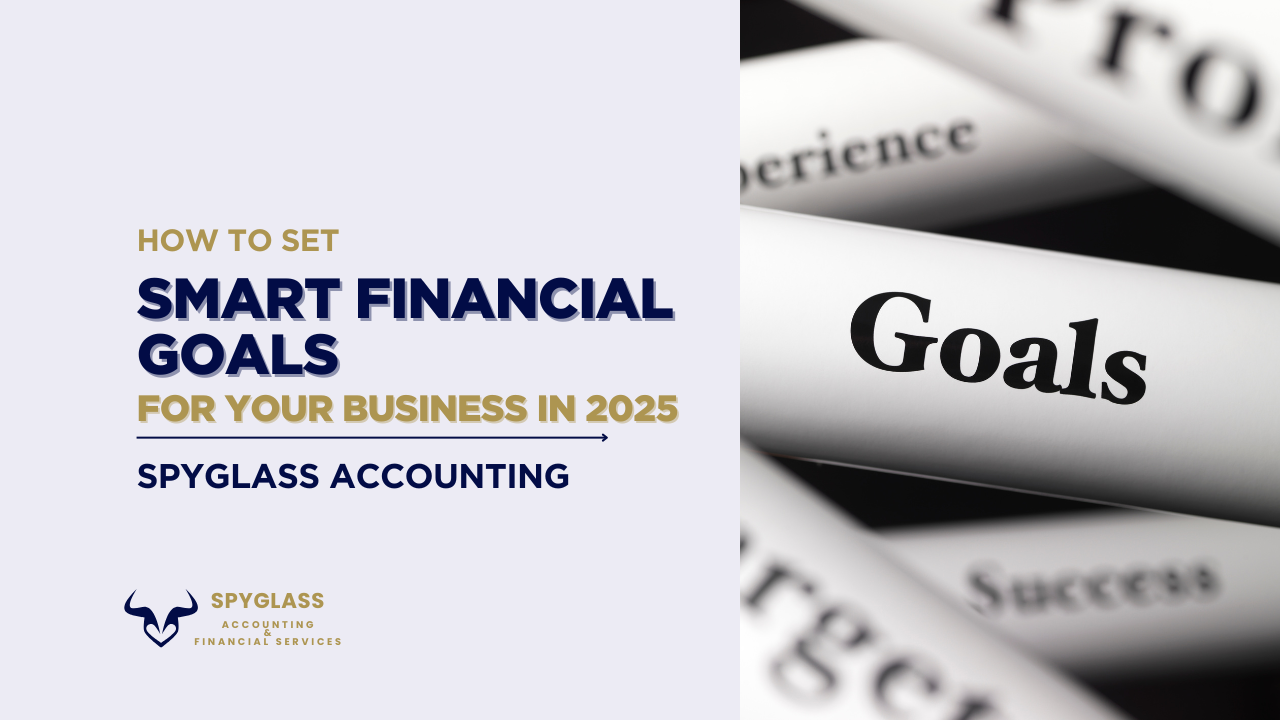
How to Set SMART Financial Goals for Your Business in 2025
Introduction: Why Financial Goals Matter for Your Business
Every successful business starts with a clear vision—but without specific, actionable financial goals, that vision remains a dream. In this blog, we will discuss how to set smart financial goals for your business in 2025.
In 2025, with economic shifts, inflation concerns, and evolving market trends, setting SMART financial goals is more critical than ever. Whether you’re a startup or an established business, structured financial planning helps you:
✅ Grow revenue strategically
✅ Control expenses effectively
✅ Improve cash flow management
✅ Prepare for economic uncertainties
✅ Align business decisions with long-term success

This guide will walk you through:
✔ What SMART financial goals are
✔ Step-by-step goal-setting strategies
✔ Common mistakes to avoid
✔ Real-world examples for small businesses
✔ Tools to track and achieve your goals
By the end, you’ll have a clear, actionable roadmap to financial success in 2025 and beyond.
- What Are SMART Financial Goals?
SMART is an acronym for:
| Letter | Meaning | Key Question |
| S | Specific | What exactly do I want to achieve? |
| M | Measurable | How will I track progress? |
| A | Achievable | Is this goal realistic? |
| R | Relevant | Does this align with my business vision? |
| T | Time-bound | When will I achieve this? |
Why SMART Financial Goals Work for Businesses
- Clarity: No vague targets like “make more money.”
- Accountability: Trackable metrics keep you on course.
- Focus: Prevents wasted effort on irrelevant objectives.
- Motivation: Deadlines create urgency.
Example of a Non-SMART vs. SMART Goal
❌ Non-SMART Goal: “Increase profits.”
✅ SMART Goal: “Increase net profit margin by 10% by Q4 2025 by reducing overhead costs and optimizing pricing strategies.”

- How to Set SMART Financial Goals (Step-by-Step)
Step 1: Analyze Your Current Financial Health
Before setting goals, assess:
✔ Revenue streams
✔ Expenses (fixed vs. variable)
✔ Cash flow trends
✔ Debt obligations
✔ Profit margins
Tool to Use: Free Financial Health Checklist
Step 2: Define Specific Goals
Ask:
- What do I want to accomplish?
- Why is this important?
Examples:
- “Increase monthly recurring revenue (MRR) from $20K to $25K by December 2025.”
- “Reduce operational costs by 8% by renegotiating vendor contracts.”
Step 3: Make Goals Measurable
Assign KPIs (Key Performance Indicators) like:
- Revenue growth %
- Customer acquisition cost (CAC)
- Gross profit margin
- Debt-to-equity ratio
Tip: Use accounting software (QuickBooks, Xero) to automate tracking.
Step 4: Ensure Goals Are Achievable
Ask:
- Do I have the resources (time, money, team)?
- Is this goal realistic based on past performance?
Example:
- If your revenue grew 5% last year, aiming for 15% next year may be unrealistic without major changes.
Step 5: Align Goals with Business Priorities
A relevant goal supports your long-term vision.
❌ Irrelevant Goal: “Open a second location” (if cash flow is unstable).
✅ Relevant Goal: *”Build a 6-month cash reserve before expanding.”*
Step 6: Set a Deadline
A time-bound goal creates urgency.
- “Pay off $15K business debt in 12 months.”
- “Save $50K for emergency funds by Q3 2025.”
- 8 SMART Financial Goal Examples for 2025
Increase Revenue by 15%
- How? Upsell existing clients, launch a new product, improve marketing ROI.
- Metric: Monthly revenue reports.
Reduce Operating Costs by 10%
- How? Switch to cost-effective vendors, automate tasks, cut unnecessary subscriptions.
- Metric: Quarterly expense audits.
Improve Cash Flow
- How? Offer early-payment discounts, tighten invoicing terms.
- Metric: Cash flow statements.
Boost Profit Margins from 12% to 18%
- How? Increase prices strategically, reduce COGS (Cost of Goods Sold).
- Metric: Profit & loss (P&L) statements.
Build a 6-Month Emergency Fund
- How? Automate savings (e.g., 5% of monthly revenue).
- Metric: Business savings account balance.
Pay Off $20K Business Debt
- How? Debt snowball method (pay smallest debts first).
- Metric: Debt reduction tracker.
Increase Customer Lifetime Value (CLV) by 20%
- How? Improve retention (loyalty programs, better service).
- Metric: Repeat customer rate.
Invest in Growth (Marketing, Tech, Hiring)
- How? Allocate 10% of profits to growth initiatives.
- Metric: ROI on investments.

- Common Financial Goal Mistakes (And How to Avoid Them)
Mistake #1: Setting Unrealistic Goals
- Fix: Base goals on historical data (e.g., past revenue growth).
Mistake #2: Ignoring Cash Flow
- Fix: Forecast 3-6 months ahead to avoid shortages.
Mistake #3: No Tracking System
- Fix: Use dashboards (Google Sheets, QuickBooks).
Mistake #4: Not Adjusting Goals
- Fix: Review quarterly and pivot if needed.
- Tools to Track & Achieve Financial Goals
| Tool | Best For |
| QuickBooks/Xero | Accounting & cash flow tracking |
| Plaid | Financial data integration |
| Asana/Trello | Goal progress tracking |
| LivePlan | Financial forecasting |
Pro Tip: Spyglass Accounting offers custom financial planning to help businesses set and hit targets.
Conclusion: Start Setting SMART Goals Today
Financial success doesn’t happen by accident—it’s planned. By setting SMART financial goals, you’ll:
✔ Make better business decisions
✔ Stay ahead of competitors
✔ Reduce financial stress

Need help? Spyglass Accounting specializes in small business financial planning. Book a free consultation today!
Additional Resources:
🔗 Importance of Business Budget in 2025
🔗 Best Accounting Software for Small Businesses
🔗 Cash Flow Management Tips
Now it’s your turn! What’s one financial goal you’re setting for 2025? Share in the comments! 🚀